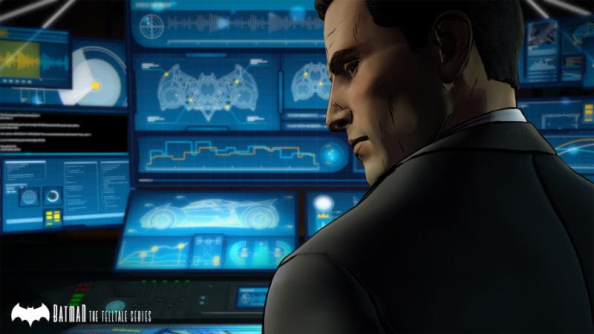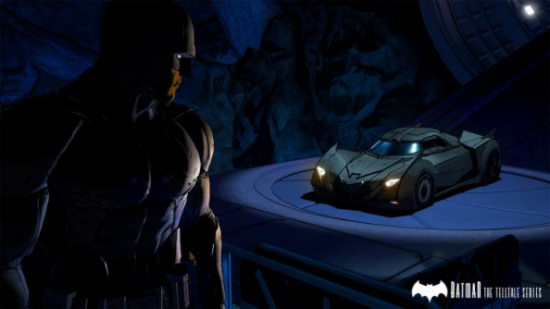Picture the scene. It’ll be easy: you’ve seen it before.
INT. THE LONG SUFFERING BANK OF GOTHAM – NIGHT
Hockey-masked goons cross the marble floor to a gilded, art deco elevator. Once upstairs they produce a circular saw, and one sets to work on a thick door. The others cradle assault rifles and pace nervously, talking gruffly over the whine of the blade.
“Do you think he’s gonna show?”
Yep: we’re back at the beginning of Batman, with a criminal class unsure whether he’s man or myth and a police force determined to stop him. James Gordon is still lieutenant. Bruce and Catwoman have never crossed paths. We’re situated firmly in, if not year one, then certainly Batman’s toddlerhood.
The Bat does show, of course, in the opening minutes of Telltale’s five part series – firing his grapple gun from an adjacent roof and ziplining through a plate-glass window. As his boot connects with a goon’s face, however, the scene smash-cuts to Bruce and Alfred, tending to Wayne’s wounds back at the mansion.
We’re going to spend a lot of time at the mansion.
“The biggest thing that you can take away from Telltale’s take on Batman is that we believe Bruce Wayne is just as important as the Batman,” says senior director Richard Iggo. “We’re fully exploring both sides of the character.”
In this first episode, that means navigating a fundraiser for Harvey Dent’s mayoral campaign.
“Being Bruce Wayne is political, it’s personal,” explains Iggo. “It’s working directly with people, seeing how you influence them and how they influence you.”
From the second he joins the gala he’s supposed to be hosting, “fashionable and fashionably late”, all eyes are on Bruce. Potential donors are there to see the famous Wayne in his expensive habitat – and it’s your decision to either give them what they want, or act as grouchily as any of us would after pulling a double.
Telltale’s Dent is some way off becoming Two-Face, but he’s no angel before the fall; he brags and boasts as shamelessly as his campaign requires him to. But his chumminess with Bruce is disarming. There’s a quiet comedy derived from the sharp whispers Dent slides your way when you’re not playing your expected part.

As the pair make their way around the room, the scene recalls the more choreographed action scenes from The Walking Dead, with fire axes swapped out for champagne glasses. The camera pans from one guest to the next, pulling in new actors as others are dismissed.
The most heavily weighted choices appear to be about, well, appearances – how you welcome your guests; whether or not you acknowledge the legacy of your parents; whose hands you choose to shake.
The important hand here is that of mafia boss Falcone, played with throaty gusto by Richard ‘Sully’ McGonagle, who turns up without an invite and sidelines Dent. In our demo, Gotham Gazette reporter Vicki Vale looks on as Iggo refuses Falcone’s advances.
These are the silent earthquakes in the Bruce portion of the game. It’s impossible to tell from a half-an-hour preview just how far these decisions will shift the story, but minutes later Falcone is spitting with fury (“Your father knew which hands to shake, and which to break. People don’t say no to me.”).
If Bruce’s sequences suggest an even wordier Walking Dead, then Batman’s scenes are The Wolf Among Us, full of crunching pugilism and dynamic direction. They’re also punctuated with the sort of one-liners that know they’re one-liners.

“Don’t you know it’s dangerous to corner a wild animal?” mocks Catwoman in a rooftop encounter.
“Then let’s put you in a cage,” booms Batman in return.
You’ll be familiar with how Telltale do QTEs by now, having more than once hammered a key to fill up a circle and swept a mouse aside in time to avoid a missile. You’ll do it again as Batman. As ever, you’re offering just enough control to put you in the body of the character without compromising the cinema – but there’s more agency here than in series past.
A segmented bat-bar in the bottom left corner of the screen builds steadily with each successful biff or pow. Once filled it can be expended with a finisher, which you can trigger whenever you like or not at all.
“They execute in very different ways,” says Iggo. “Some of them are relatively small, some of them are very showy.”
Fights can be failed – in life-or-death moments that require a scene reset, yes, but also in ways that’ll affect the direction of the plot. Most compellingly, Telltale say there will be key moments in the season when players will get to pick how they dress for an occasion: will they go as Bruce, or as Batman?

In future episodes there’ll be detective work, too; it’d be a waste of the world’s greatest detective otherwise. Telltale say those scenes don’t resemble anything in their previous games.
I’m optimistic that the series will get better as it goes on – if only because the developers have picked the most drearily well-trodden starting point in the timeline.
When Alfred warns Bruce off spending too much time in the company of darkness, juggling dual roles as butler and Captain Obvious, it’s hard not to remember how many times we’ve heard that story before. Even Nietzsche himself would be bored of this patter by now.
But Telltale ask for the benefit of the doubt – hinting that this Alfred, Dent, Falcone et al are “more familiar names than familiar faces”.
“You will not have seen this story before,” reassures Iggo. “You might feel like you know these characters and are very comfortable with where this is going. But trust me, it’s all going to be turned on its head.”
